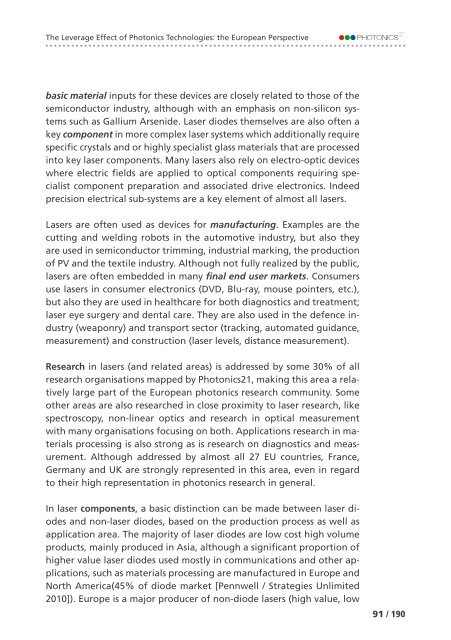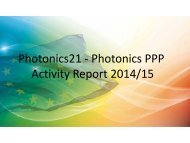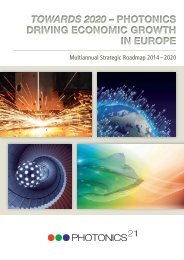of Photonics Technologies: the European Perspective The Leverage Effect
You also want an ePaper? Increase the reach of your titles
YUMPU automatically turns print PDFs into web optimized ePapers that Google loves.
<strong>The</strong> <strong>Leverage</strong> <strong>Effect</strong> <strong>of</strong> <strong>Photonics</strong> <strong>Technologies</strong>: <strong>the</strong> <strong>European</strong> <strong>Perspective</strong><br />
basic material inputs for <strong>the</strong>se devices are closely related to those <strong>of</strong> <strong>the</strong><br />
semiconductor industry, although with an emphasis on non-silicon systems<br />
such as Gallium Arsenide. Laser diodes <strong>the</strong>mselves are also <strong>of</strong>ten a<br />
key component in more complex laser systems which additionally require<br />
specific crystals and or highly specialist glass materials that are processed<br />
into key laser components. Many lasers also rely on electro-optic devices<br />
where electric fields are applied to optical components requiring specialist<br />
component preparation and associated drive electronics. Indeed<br />
precision electrical sub-systems are a key element <strong>of</strong> almost all lasers.<br />
Lasers are <strong>of</strong>ten used as devices for manufacturing. Examples are <strong>the</strong><br />
cutting and welding robots in <strong>the</strong> automotive industry, but also <strong>the</strong>y<br />
are used in semiconductor trimming, industrial marking, <strong>the</strong> production<br />
<strong>of</strong> PV and <strong>the</strong> textile industry. Although not fully realized by <strong>the</strong> public,<br />
lasers are <strong>of</strong>ten embedded in many final end user markets. Consumers<br />
use lasers in consumer electronics (DVD, Blu-ray, mouse pointers, etc.),<br />
but also <strong>the</strong>y are used in healthcare for both diagnostics and treatment;<br />
laser eye surgery and dental care. <strong>The</strong>y are also used in <strong>the</strong> defence industry<br />
(weaponry) and transport sector (tracking, automated guidance,<br />
measurement) and construction (laser levels, distance measurement).<br />
Research in lasers (and related areas) is addressed by some 30% <strong>of</strong> all<br />
research organisations mapped by <strong>Photonics</strong>21, making this area a relatively<br />
large part <strong>of</strong> <strong>the</strong> <strong>European</strong> photonics research community. Some<br />
o<strong>the</strong>r areas are also researched in close proximity to laser research, like<br />
spectroscopy, non-linear optics and research in optical measurement<br />
with many organisations focusing on both. Applications research in materials<br />
processing is also strong as is research on diagnostics and measurement.<br />
Although addressed by almost all 27 EU countries, France,<br />
Germany and UK are strongly represented in this area, even in regard<br />
to <strong>the</strong>ir high representation in photonics research in general.<br />
In laser components, a basic distinction can be made between laser diodes<br />
and non-laser diodes, based on <strong>the</strong> production process as well as<br />
application area. <strong>The</strong> majority <strong>of</strong> laser diodes are low cost high volume<br />
products, mainly produced in Asia, although a significant proportion <strong>of</strong><br />
higher value laser diodes used mostly in communications and o<strong>the</strong>r applications,<br />
such as materials processing are manufactured in Europe and<br />
North America(45% <strong>of</strong> diode market [Pennwell / Strategies Unlimited<br />
2010]). Europe is a major producer <strong>of</strong> non-diode lasers (high value, low<br />
91 / 190






